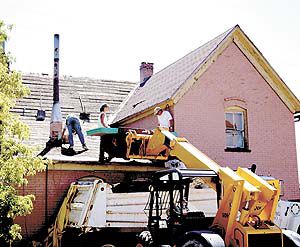| Construction workers repair the roof at the Bryner home on July 27. The home is the planned site of a future museum of the county’s ethnic history. |
Plans to create a new Pioneer museum took another step forward as crews began repair and restoration on the roof of the Bryner home located on the corner of 100 South and 100 East in Price late last week.
The house, which has been used as a residence and has housed various businesses for more than a century, is set to be restored and will become the Bryner Pioneer Museum Foundation. The foundation plans to educate and immerse patrons into everyday life of early Carbon County.
Sue Christensen and Rita Alderson who have taken the responsibility of leading this project, know the importance of using the Bryner home as a museum and hope that Carbon County residents realize that as well.
“The only way to make this project a success is to have the support of the whole community of Carbon County,” said Christensen.
Bruce Bryner, the current owner of the house also likes the idea of preserving the county’s heritage since he can trace his own to one of the earliest settlers of Price, Hans Ulrich Bryner. Bryner realizes that he shares a common bond with many residents of Carbon County by tracing his roots not solely to Mormon Pioneers but to European immigrants as well.
“Everybody knows the importance of our early Mormon pioneers but there really isn’t a place to remember our ethnic heritages. What we want is a museum for both,” said Bryner.
The Bryner home was originally built in 1890 by Albert Bryner, the son of Hans Ulrich Bryner who was one of the earliest settlers of Price.
Hans’ likeness is painted on the first floor mural in the Price Municipal Building by his grandson Lynn Fausett. Hans was born in Ilnon, Canton of Zurich, Switzerland, on April 29, 1827. He came to Utah in 1856 and married Margaret Kuhn in 1868 and together they settled in Price in 1884.
Initially the Daughters of Utah Pioneers applied for grants to fund the museum but now Christensen has decided to incorporate the foundation into a tax exempt 501(c)(3) entity.
“To belong to the DUP you must be female and secondly you must trace relatives who arrived here before 1869. Since many of the Greeks and Italians and even Japanese immigrants didn’t arrive here until the early 1880s when the Denver and Rio Grande railroads came through, we would be doing Carbon County a great disservice,” said Christensen.
One of the main benefits of tax-exempt status is the ability to accept donations and contributions that are tax-deductible to the donor. Additional benefits include permission to raise funds by receiving public and private grant money which is exactly what Christensen has set out to do.
To incorporate the entire community, Christensen and Bryner have a unique vision of what the museum will offer to its visitors. The idea will be one of a hands-on museum allowing visiting patrons to participate in the everyday labors that early pioneers had to face such as making cheese, bread and candles all from scratch. Original furniture and artifacts will be on display as well. There are even plans to transform the old grainary located directly behind JC Penney into a blacksmith shop where patrons could forge horseshoes and other various tools.
In addition, the foundation would also like to educate the public of Carbon County’s diverse ethnic heritages. The museum would like to include exhibits of all who have immigrated from eastern and southern European countries, Asia, Mexico and Native Americans.
In order for this to happen the foundation would like to have contributions other than monetary to their museum such as original furniture, tools, and photographs. Written accounts of family histories are highly sought after not only for their genealogical records but also for their historical accounts. Local artists are invited to display their work in what will become a community donated gift shop where people will have a chance to display their work commemorating the history of the Castle Valley.
“People and businesses have been very generous to our cause such as supporting our yard sale and private donations. Hopefully people can see that we are taking steps such as repairing the roof and know that we are serious and can donate not just money but also help in stripping paint, making curtains and other improvements to the house,” said Christensen.

